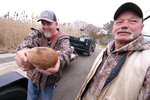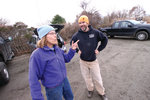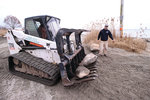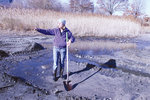Ward 5 Councilman Ed Ladouceaur will tell you you’ll never know what you’ll find on Longmeadow Beach.
It could be a mattress, the remains of a kitchen table, a smashed car fender or the …
This item is available in full to subscribers.
We have recently launched a new and improved website. To continue reading, you will need to either log into your subscriber account, or purchase a new subscription.
If you are a current print subscriber, you can set up a free website account by clicking here.
Otherwise, click here to view your options for subscribing.
Please log in to continue |
|




Ward 5 Councilman Ed Ladouceaur will tell you you’ll never know what you’ll find on Longmeadow Beach.
It could be a mattress, the remains of a kitchen table, a smashed car fender or the battered hull of a skiff. He’s seen it all, especially in late June when the junk along with driftwood, even whole trees, are piled high for a Fourth of July bonfire.
But would he have ever guessed a coconut?
DEM Division of Fish & Wildlife biologist Tanner Steeves held up the coconut Friday morning.
“Pina coladas,” he suggested to the DEM crew putting finishing touches to the Longmeadow Fishing area at the end of Samuel Gorton Avenue. Dennis Timpson shook the nut. There was no mistaking the sound of something inside – maybe milk, maybe the dried meat.
Indeed, the beach at Longmeadow offers a commanding view of upper Narragansett Bay, although it isn’t a tropical paradise. There are no coconut trees. To the north is Conimicut Light. Rocks jut from the waters to the east and Rocky Point is to the south.
Longmeadow has a rich history of shoreline transition. Summer collages and bungalows once lined the beach. There was even a road that ran parallel to the water. The great storm of 1938, before hurricanes were named, and subsequent hurricanes have wiped away those homes.
But there’s more at work. What’s left of the road is only exposed during extreme low tides, if at all. Bits of asphalt mixed in with stones, sand and shells – even the errant coconut – attest to its former existence. Broken pilings beyond the breaking waves are the remains of multiple docks.
Rising waters and storms are taking the land.
So it would seem futile to save this beach – no less create a parking lot suitable for about 20 cars, open an access to launch kayaks and encourage people to come, walk the beach, open a beach chair and watch the bay tankers follow the channel to Providence or even just swing by early enough to see the sun rise from the comfy interiors of their cars.
Moon tides and the storms will continue to flood the area. Wenley Ferguson, restoration coordinator for Save The Bay, knows that, but thanks to the work done through a partnership between the Coastal Resources Management Council, Save The Bay and the city, she expects it will be more resilient. She also sees the work done last week as cleaning up debris including chunks of concrete and asphalt, reconfiguring drainage so as to lessen erosion, denying motor vehicle access to the beach and of equal importance leveling areas where vehicles have compacted the ground and created depressions for the pooling of runoff and tidal waters.
Ferguson isn’t a behind-the-desk planner.
On Thursday, she was on site in boots and carrying a shovel as a city grader leveled the parking area, pitching it so it would drain and a backhoe cut a trench to release the ponding of tidal waters near the shoreline. She was back on Friday when trucks brought in loads of sand to reinforce dunes.
“The bay is moving inland,” Ferguson says. She estimates about 150 feet of Longmeadow shoreline has been lost to the bay since the 1930s. It’s anyone’s guess how long the improvements will last. A major storm could change everything.
Steeves acknowledges that could happen, yet until it does he reasons people will have access to the bay and the area will be given the opportunity to rebound. He said under the partnership CRMC provided $5,000 through an Estuarine Habitat Restoration Trust Fund grant while DEM, the city and Save the Bay provided in-kind services. The project was two years in planning.
1 comment on this item Please log in to comment by clicking here
JohnStark
Unmentioned in the otherwise fine article is the fact that local criminals use the area in front of the beach as a dump. I've found everything from surplus asphalt, mattresses, and air conditioners to fences, tires, and refrigerators. Many of those articles became kindling for the once-annual 4th of July bonfire, which got out of control and is now a memory. Save the Bay does a clean up a couple of times a year down there, and the haul of garbage is staggering! The boat ramp was also taken out a few years ago, limiting access for local small boats. Lack of use equates to vandalism and dumping. Too bad. Nice area.
Tuesday, December 3, 2019 Report this